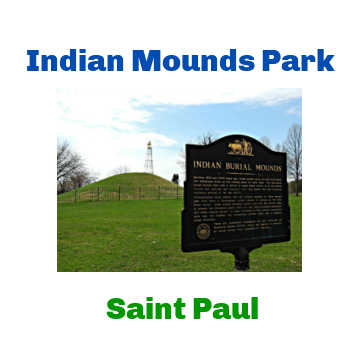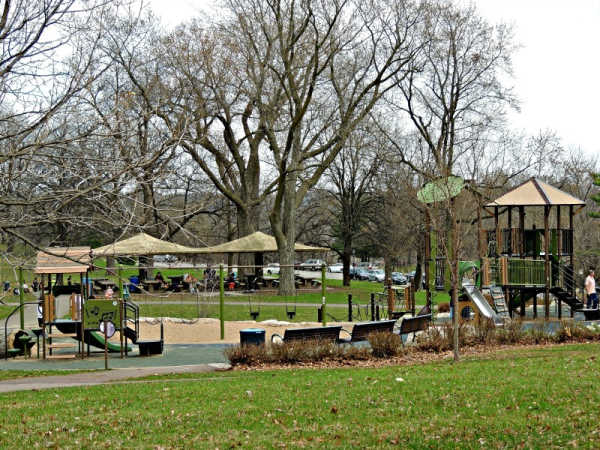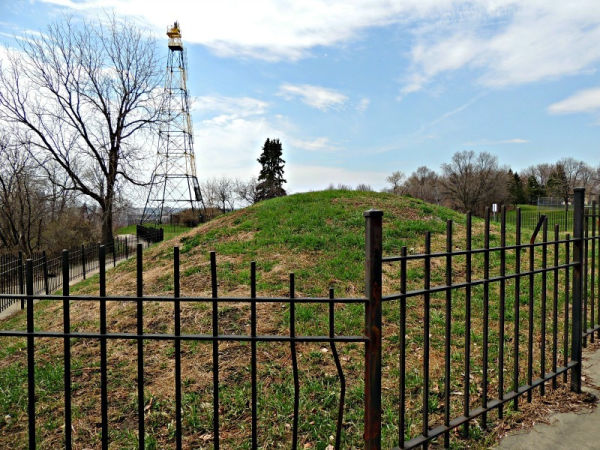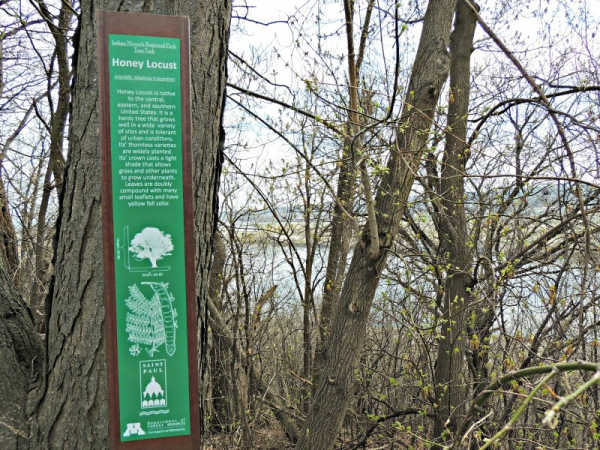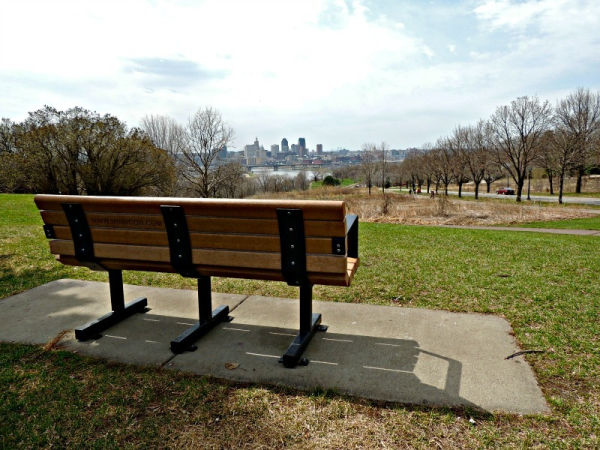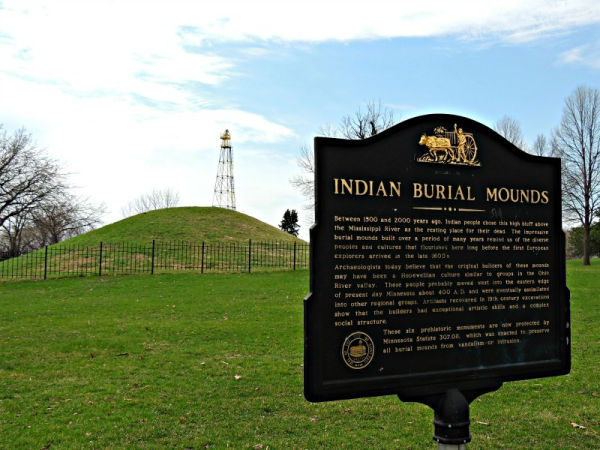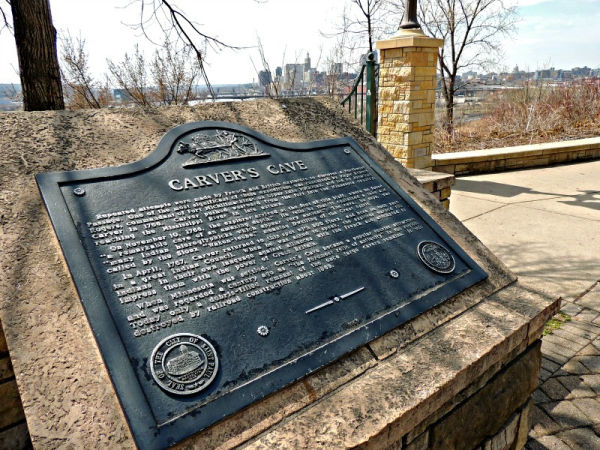Indian Mounds Regional Park is located on the scenic bluffs of the Mississippi River on the eastern side of downtown Saint Paul. A place of deep significance to some indigenous peoples, families can spend an afternoon exploring the land’s historical significance or study the native trees on the land. The park has family friendly amenities that include a playground, a picnic area and grills, trails for biking and hiking, public art and the historic burial mounds it is named for. There is also a shelter and restrooms onsite. In 2020, The city of Saint Paul Parks & Rec began a collaboration with the Minnesota Indian Affairs Council and Native Americans to insure continued protection of sacred place of burial, interpretation, stewardship, while improving the park in the form of a Cultural Landscape Plan and a trail reconstruction project. Trails were updated in 2020. Sitework for prairie restoration began in spring of 2023, that included installation of prairie. New storytelling stones were added to the trail from Earl Street toward the location of the airway beacon. Keep up-to-date with the project here. If you have a kid who is interested in botany or maybe just likes leaves, you can go on a self-guided Tree Trek through the park. This nature trail will lead hikers through the park to view a variety of native trees. Find a map here, and enjoy a mile hike around the park that leads you to 28 different types of trees. Find this and other ideas in our article, Twin Cities Quests and Treasure Hunts for Families. The St. Paul goats are back for the summer of 2020! As with previous years, they will be rotated between Indian Mounds, Hidden Falls Regional Park and Crosby Regional Park to help control invasive buckthorn. Track the goats at the Great River Passage website. While, fighting off the buckthorn, St. Paul Natural Resources has also restored over 3.5 acres of native prairie at Indian Mounds Regional Park and Como Regional Park. There are two shelters available for rental at this park. For more information about reserving a shelter, call the Park Permit Office at 651-632-5111 between 7:00 a.m. to 3:30 p.m. weekdays. The Indian Mounds Splash Pad Project has been scrapped. Funds have been re-allocated to the cultural resources project. It is possible this project could be revived at a later date, but there are no current plans. The following information has been reprinted courtesy of MNopedia under a Creative Commons License and may be reprinted under the same license. Archaeologists date the construction of the surviving mounds to between 200 BCE and 400 CE (a period called Middle Woodland) based on their similarity to mounds elsewhere in the Midwest. The tallest mound at the St. Paul site fits the pattern, observed elsewhere, of being the oldest. Creator: Paul Nelson Indian Mounds Landscape Plan and Trail Project
Indian Mounds Regional Park Tree Trek
Watch for Goats at Indian Mounds Regional Park
Birthday Parties at Indian Mounds Park
Indian Mounds Regional Park Splash Pad – Not Happening
Historic Significance of Indian Mounds Regional Park
The size, contents, and location of the mounds suggest that they held great religious or ceremonial importance for their builders. Archaeologists have concluded that they were American Indian people who shared some cultural characteristics with, or at least had contact with, the mound-building people of southern Ohio and western Illinois, and that the ideas and practices that motivated mound building moved north along the Mississippi. The cultural complex of these other mound builders bears the name Hopewell, from a farm in Ohio.
Certainly, the various peoples of North America maintained vast exchange networks: grave goods in the Upper Mississippi valley have included obsidian from Wyoming and shells from Florida. The mounds have been a sacred site for some modern and early modern Native people—particularly the Dakota—since before the mid-1700s.
The first person to map the St. Paul mounds, Theodore H. Lewis, began around 1880. He determined that there had once been fifty-eight mounds at the brow of what came to be known as Dayton’s Bluff, a promontory two hundred feet above the Mississippi River where it takes a turn south toward the Gulf of Mexico. At the top stood a group of eighteen, some of them tall and cone-shaped. The rest, most of them low, trailed along the bluff as it descended toward the north. Most of these were only a foot or two above the natural surface. When Lewis mapped them, only thirty nine remained.
Developers destroyed many of the small mounds in the late nineteenth century in order to build the Dayton’s Bluff neighborhood. The City of St. Paul razed seven more mounds in 1895 in the grading of Mounds Park Boulevard and the creation of Indian Mounds Park. It preserved the six tallest, which are also believed to be the oldest.
Looters, investigators, and road workers dug into at least seventeen of the mounds. Inside, they found wood and stone burial chambers, copper and stone grave goods, sea shell beads, mussel shells, and the remains of approximately fifty people, including a few children. The most remarkable object removed, in 1882, was a small child’s skull bearing a clay mask. The known excavations began in 1856 and ended in 1895, but looters may have been active both before and after.
Some of the objects and remains taken from the mounds were destroyed in a fire at the state capitol in 1881. Others, held at Macalester College from 1887 until 1955, including a copper breastplate, were stolen by collectors. The Minnesota Historical Society holds the only known surviving artifacts from the St. Paul mounds: seventeen projectile points, a small earthenware vessel, a box of small shells, and a glass bottle of red ocher.
Archaeologists completed a survey and some testing of the site in 1981, but the mounds themselves were not entered. In 2013, archaeologists used modern methods (including radar and magnetic gradiometry) to examine the mound site, with scant results. The Native American Graves Protection and Repatriation Act (NAGPRA), which became law on November 16, 1990, regulates management of the remaining artifacts that had been acquired by museums and other public institutions.
Cite: Nelson, Paul. “Indian Mounds Park, St. Paul.” MNopedia, Minnesota Historical Society. http://www.mnopedia.org/place/indian-mounds-park-st-paul (accessed August 3, 2017).
The Family Fun Twin Cities Directory is the most extensive collection of companies, organizations, activities and places to find things to do with kids in the Twin Cities.
Family Fun Twin Cities is not associated with the companies, municipalities or organizations and cannot book your birthday party, reserve sites or pass on complaints. Please use the contact information we provide.
Sharing of information is not an endorsement. We do, however, welcome constructive reviews from readers. Please feel free to leave comments providing helpful tips and information for other parents.

